Cool Aztec Designs to Draw
The Aztec culture, centred at the capital of Tenochtitlan, dominated most of Mesoamerica in the 15th-16th centuries. With military machine conquest and trade expansion, the art of the Aztecs also spread, helping the Aztec civilization achieve a cultural and political hegemony over their subjects and creating for posterity a tangible tape of the artistic imagination and great talent of the artists from this last great Mesoamerican civilization.
Influences
Common threads run through the history of Mesoamerican civilization and particularly in art. The Olmec, Maya, Toltec, and Zapotec civilizations, amongst others, perpetuated an artistic tradition which displayed a love of monumental stone sculpture, imposing compages, highly decorated pottery, geometric stamps for fabric and body art, and breathtaking metalwork which were all used to stand for people, animals, plants, gods and features of religious ceremony, peculiarly those rites and deities connected to fertility and agriculture.
Aztec artists were also influenced by their contemporaries from neighbouring states, peculiarly artists from Oaxaca (a number of whom permanently resided at Tenochtitlan) and the Huastec region of the Gulf Coast where there was a potent tradition of iii-dimensional sculpture. These diverse influences and the Aztecs' own eclectic tastes and admiration of ancient fine art made their art one of the nigh varied of all ancient cultures anywhere. Sculptures of gruesome gods with abstract imagery could come from the same workshop as naturalistic works which depicted the beauty and grace of the beast and human form.
Features of Aztec Art
Metalwork was a particular skill of the Aztecs. The corking Renaissance artist Albrecht Drurer saw some of the artefacts brought dorsum to Europe which caused him to say, '...I have never seen in all my days that which so rejoiced my centre, every bit these things. For I saw among them amazing artistic objects, and I marvelled over the subtle ingenuity of the men in these distant lands'. Unfortunately, as with most other artefacts, these objects were melted down for currency, then very few examples survive of the Aztecs' fine metalworking skills in gilded and silver. Smaller items accept been discovered, among them golden labrets (lip piercings), pendants, rings, earrings and necklaces in gold representing everything from eagles to tortoise shells to gods, which are testimony to the skills in lost-wax casting and filigree piece of work of the finest artisans or tolteca.
The Aztecs also employed art equally a tool to reinforce their military & cultural dominance across Mesoamerica.
Aztec sculpture has been a better survivor, and its bailiwick was very oftentimes individuals from the extensive family of gods they worshipped. Carved in rock and woods these figures, sometimes monumental in size, were not idols containing the spirit of the god, equally in Aztec faith the spirit of a item deity was thought to reside in sacred bundles kept within shrines and temples. All the same, it was thought necessary to 'feed' these sculptures with blood and precious objects, hence tales from the Spanish conquistadors of huge statues splattered with blood and encrusted with jewels and gold. Other big sculptures, more in the round, include the magnificent seated god Xochipilli and the various chacmools, reclining figures with a hollow carved in the chest which was used as a receptacle for the hearts of sacrificial victims. These, as with well-nigh other Aztec sculpture, would take once been painted using a wide range of bright colours.
Smaller-calibration sculpture has been found at sites across Central Mexico. These oft take the form of local deities and especially gods related to agriculture. The most common are upright female figures of a maize deity, typically with an impressive headdress, and the maize god Xipe Totec. Lacking the finesse of purple-sponsored art, these sculptures and like pottery figures often represent the more benevolent side of the Aztec gods.
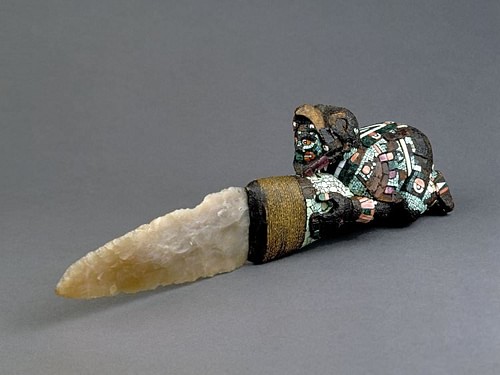
Aztec Ceremonial Knife
Miniature work was also pop where subjects such every bit plants, insects, and shells were rendered in precious materials such every bit carnelite, pearl, amethyst, rock crystal, obsidian, vanquish, and the most highly valued of all materials, the precious stone jade. One other cloth which was highly prized was exotic feathers, especially the green plumage of the quetzal bird. Feathers cutting up into small pieces were used to create mosaic paintings, as decoration for the shields of Aztec warriors, costumes and fans, and in magnificent headdresses such as the one ascribed to Motecuhzoma II which is now in the Museum für Völkerkunde in Vienna.
Turquoise was a particularly favoured cloth with Aztec artists, and the use of it in mosaic form to cover sculpture and masks has created some of the almost striking imagery from Mesoamerica. A typical example is the decorated human skull which represents the god Tezcatlipoca and which at present resides in the British Museum, London. Another fine example is the mask of Xiuhtecuhtli, the god of burn, with sleepy-looking mother-of-pearl optics and a perfect fix of white conch shell teeth. Finally, in that location is the magnificent double-headed ophidian pectoral, also now in the British Museum. With carved cedar woods completely covered in pocket-sized squares of turquoise and the red mouths and white teeth rendered in spondylus and conch shell respectively, the piece was probably once function of a formalism costume. The snake was a potent image in Aztec art as the animal, able to shed its skin, represented regeneration and was also particularly associated with the god Quetzalcoatl.
Despite the absence of the potter's bike, the Aztecs were as well skilled with ceramics as indicated by large hollow figures and several beautifully carved lidded-urns which were excavated by the side of the Templo Mayor at Tenochtitlan, probably used as receptacles for funeral ashes. Other examples of ceramic works are the moulded censers with tripod legs from Texcoco, spouted jugs, and elegant hourglass-shaped cups. These vessels are typically thin-walled, well proportioned, have a cream or red and black slip, and bear finely painted geometric designs in earlier designs and flora and animate being in afterwards examples. The most highly-prized ceramics by the Aztecs themselves, and the blazon which Motecuhzoma himself used, were the ultra-thin Cholula ware from Cholollan in the Valley of Puebla. Vessels could also be made from moulds or carved while the clay was still leather-hard. A fine example of these anthropomorphic vessels is the celebrated vase representing the caput of the pelting god Tlaloc painted a bright blueish, with goggle eyes and fearsome reddish fangs, at present in the National Museum of Anthropology in Mexico City.
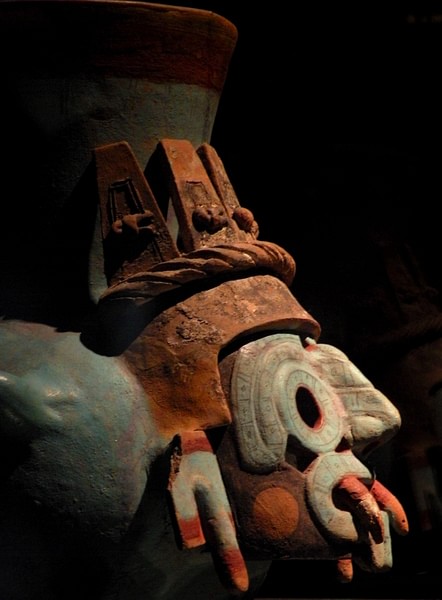
Tlaloc
Musical instruments were some other important office of the Aztec artist'southward repertoire. These included ceramic flutes and wooden teponaztlis and huehuetls, respectively, long and upright formalism drums. They are richly decorated with carvings, and i of the finest is the Malinalco drum which is covered in dancing jaguars and eagles who represent sacrificial victims as indicated past banners and speech scrolls of warfare and burn symbols.
Art as Propaganda
The Aztecs, as with their cultural predecessors, employed art as a tool to reinforce their military and cultural potency. Imposing buildings, frescoes, sculpture and fifty-fifty manuscripts, particularly at such key sites as Tenochtitlan, not only represented and even replicated the key elements of Aztec religion, merely they also reminded subject peoples of the wealth and power which permitted their construction and manufacture.
The supreme example of this use of art as a conveyor of political and religious messages is the Templo Mayor at Tenochtitlan which was much more than a hugely impressive pyramid. Information technology was carefully designed in every item to represent the sacred serpent mount of the earth Coatepec, so important in Aztec religion and mythology. This mountain was the site where Coatlicue (the globe) gave nascence to her son Huitzilopochtli (the sun), who defeated the other gods (the stars) led past his sister Coyolxauhqui (the moon). A temple to Huitzilopochtli was built on top of the pyramid along with another in honour of the rain god Tlaloc. Further associations with the myth are the snake sculptures lining the base and the Great Coyolxauhqui Rock carved in c. 1473, also found at the base of the pyramid and which represents in relief the dismembered body of the fallen goddess. The stone, along with other such sculptures equally the Tizoc Rock, related this catholic imagery to the contemporary defeat of local enemies. In the case of the Coyolxauhqui Stone, the defeat of the Tlatelolca is being referenced. Finally, the Templo Mayor was itself a repository of fine art as, when its interior was explored, a vast hoard of sculpture and art objects were discovered entombed with the remains of the dead and these pieces are, in many cases, works that the Aztecs had themselves collected from more ancient cultures than their own.
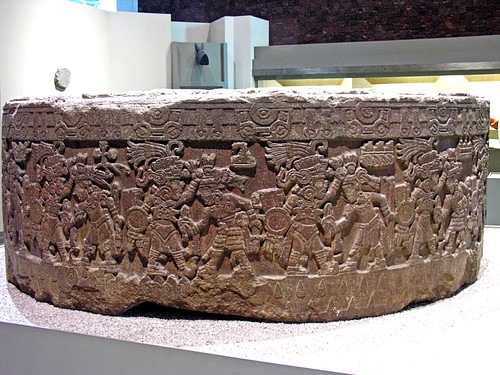
Tizoc Stone
Temples extolling the Aztec view of the world were as well constructed in conquered territories. The Aztecs unremarkably left existing political and administrative structures in place, but they did impose their own gods in a bureaucracy above local deities, and this was largely done through architecture and art, backed up with sacrificial ceremonies at these new sacred places, typically constructed on previous sacred sites and often in spectacular settings such as on mountain peaks.
The Dominicus Stone was carved c. 1427 & shows a solar deejay which presents the v consecutive worlds of the sunday from Aztec mythology.
Aztec imagery which spread across the empire includes many lesser-known deities than Huitzilopochtli and at that place are a surprising number of examples of nature and agricultural gods. Possibly the most famous are the reliefs of the water goddess Chalchiuhtlicue on the Malinche Hill most ancient Tula. These and other works of Aztec art were well-nigh frequently made past local artists and may have been commissioned by authorities representing the land or by private colonists from the Aztec heartland. Architectural art, rock carvings of gods, animals and shields, and other fine art objects have been found across the empire from Puebla to Veracruz and specially around cities, hills, springs, and caves. Further, these works are usually unique, suggesting the absence of any organised workshops.
Masterpieces
The big round Stone of Tizoc (carved c. 1485 from basalt) is a masterful mix of cosmic mythology and real-earth politics. It was originally used as a surface on which to perform homo sacrifice and every bit these victims were usually defeated warriors it is entirely appropriate that the reliefs around the edge of the stone draw the Aztec ruler Tizoc attacking warriors from the Matlatzinca, an area conquered by Tizoc in the late 15th century CE. The defeated are as well portrayed as Chichimecs i.e. landless barbarians, whilst the victors wear the noble dress of the revered ancient Toltec. The upper surface of the stone, 2.67 one thousand in diameter, depicts an 8-pointed sun-deejay. The Rock of Tizoc now resides in the National Museum of Anthropology in Mexico City.
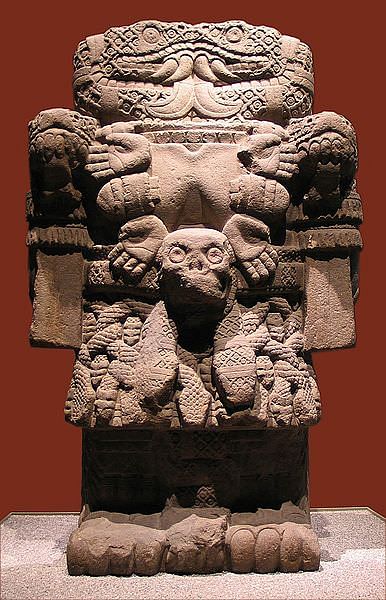
Coatlicue
The massive basalt statue of Coatlicue (carved in the final one-half-century of Aztec rule) is widely considered i of the finest examples of Aztec sculpture. The goddess is presented in terrifying form with 2 snakeheads, clawed anxiety and hands, a necklace of dismembered easily and human hearts with a skull pendant, and wearing a brim of writhing snakes. Perhaps i of a grouping of four and representing the revelation of female power and terror, the three.five m high statue leans slightly forward so that the overall dramatic effect of the piece is so emotive that information technology is understandable why the statue was actually re-cached several times post-obit its original earthworks in 1790. The statue of Coatlicue now resides in the National Museum of Anthropology in Mexico City.
The Lord's day Stone, as well known as the Aztec Calendar Stone (despite the fact that it is not a functioning calendar), must be the about recognisable fine art object produced by any of the great civilizations of Mesoamerica. Discovered in the 18th century nigh the cathedral of Mexico City, the stone was carved c. 1427 and shows a solar disk which presents the v sequent worlds of the sun from Aztec mythology. The basalt stone is three.78 m in diameter, almost a metre thick and was in one case part of the Templo Mayor complex of Tenochtitlan. At the centre of the stone is a representation of either the dominicus god Tonatiuh (the Twenty-four hour period Sun) or Yohualtonatiuh (the Night Dominicus) or the primordial globe monster Tlaltecuhtli, in the latter case representing the final destruction of the world when the 5th sunday fell to world. Around the central face at four points are the other four suns which successively replaced each other after the gods Quetzalcoatl and Tezcatlipoca struggled for control of the cosmos until the era of the 5th sunday was reached. On either side of the central face are 2 jaguar heads or paws, each clutching a middle, representing the terrestrial realm. The two heads at the bottom centre represent fire serpents, and their bodies run around the perimeter of the stone with each ending in a tail. The 4 cardinal and the inter-cardinal directions are also indicated with larger and lesser points respectively.
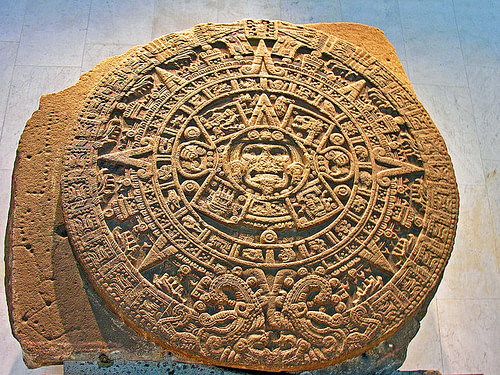
Aztec Dominicus Rock
As one final case of the wealth of Aztec art which has survived the best destructive efforts of their conquerors, at that place is the life-sized eagle warrior from Tenochtitlan. The effigy, seemingly about to take flying, is in terracotta and was made in 4 separate pieces. This Hawkeye Knight wears a helmet representing the bird of prey, has wings and fifty-fifty clawed feet. Remains of stucco suggest that the figure was one time covered in real feathers for an fifty-fifty more life-like effect. Originally, it would have stood with a partner, either side of a doorway.
Conclusion
Following the fall of the Aztec Empire the production of indigenous art went into decline. However, some designs of the Aztec civilisation lived on in the piece of work of local artists employed past Augustinian friars to decorate their new churches during the 16th century. Manuscripts and feather paintings too continued to be produced, merely it was non until the late 18th century that an interest in Precolumbian art and history would atomic number 82 to a more systematic investigation of just what lay under the foundations of modern Mexican cities. Slowly, an ever-growing number of Aztec artefacts take revealed, in case there had ever been any doubt, proof-positive evidence that the Aztecs were amidst the most aggressive, creative, and eclectic artists that Mesoamerica had e'er produced.
This article has been reviewed for accurateness, reliability and adherence to bookish standards prior to publication.
Source: https://www.worldhistory.org/Aztec_Art/
0 Response to "Cool Aztec Designs to Draw"
Post a Comment